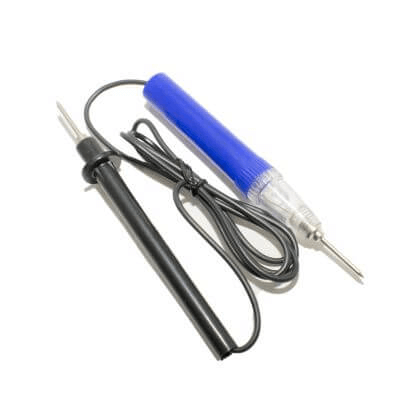What Is a Continuity Checker?

A continuity checker is a measuring instrument used to verify that electricity is flowing between two electrodes in an electrical circuit.
With a continuity checker, you can quickly determine if there is a problem with the circuit or if the wiring is properly connected. There are a variety of types available, ranging from simple pen-type devices to those with high-precision digital display functions.
Generally, these devices are used by professionals in electrical work. However, they can also be purchased relatively inexpensively at home centers.
Uses of Continuity Checkers
Continuity checkers are inspection instruments used to detect continuity or disconnection of electrical circuits, and are used for the following applications
1. Checking Wiring Connections
Used to verify that wiring connections are correct. By using a continuity checker, it is possible to quickly check if the wiring is connected properly and if there is any disconnection or poor contact.
2. Testing Electronic Circuits
A continuity checker is used to test whether components and circuits in an electronic circuit are properly connected. A continuity checker can be used to determine if components and circuits are functioning properly, for example, if relay contacts are in an ON/OFF state under certain conditions.
3. Checking Electrical Work
During electrical work, a continuity checker can be used to check wire connections and wiring continuity to ensure safe and reliable electrical installations.
4. Troubleshooting Electrical Equipment
A continuity checker can be used to identify malfunctions in electrical equipment. For example, if electrical equipment does not work, a continuity checker can be used to identify problems with the power supply or wiring.
Principle of Continuity Checkers
Typically, continuity checkers use two probes (sharp metal rods) to connect the two ends of an electrical circuit. It has an internal circuit, such as a power supply or oscillator, which transmits signals generated by the circuit to the electrical circuit through the probes.
A continuity checker detects whether the transmitted signal passes through the circuit or not. If it detects the passage of a signal, it displays the result on a display device. Typical indicators include LED lamps and buzzers that light or sound when a signal is detected.
When an electrical circuit is conducting, the continuity checker signal passes because of the current flow. On the other hand, if the electrical circuit is disconnected, the signal will not pass because no current flows. In this way, continuity checkers can detect continuity or disconnection of an electrical circuit.
Types of Continuity Checkers
There are the following types of continuity checkers:
1. Pen-Type Continuity Checker
Shaped like a pen, the pen-type continuity checker checks the continuity of a circuit by placing the pointed probe against the electrode. It is easy to operate and use, and is often used for beginners.
2. Multimeter Type Continuity Checker
This continuity checker is equipped with a digital display and also has measurement functions such as ohmmeter, voltmeter, and ammeter. They are more accurate and can make more precise measurements, but are complicated to operate and not suitable for beginners.
3. Continuity Checker With LED Light
This continuity checker allows the user to check the continuity of a circuit by means of a lighted LED light. It is easy to operate, easy to see, and easy to use.
4. Stylus-Type Continuity Checker
This is a stylus-type continuity checker that checks continuity by touching the probe. Since it can be handled intuitively, it is said to be easier to operate than general pen-type continuity checkers.